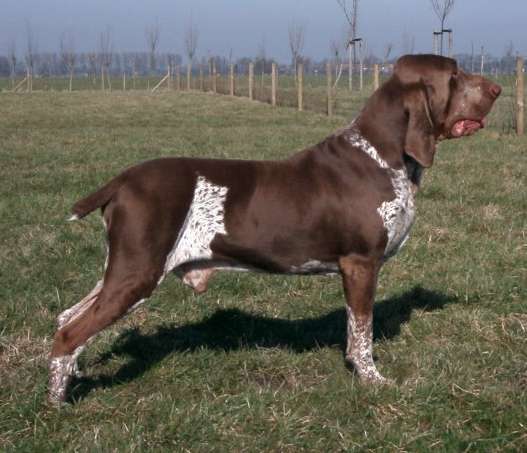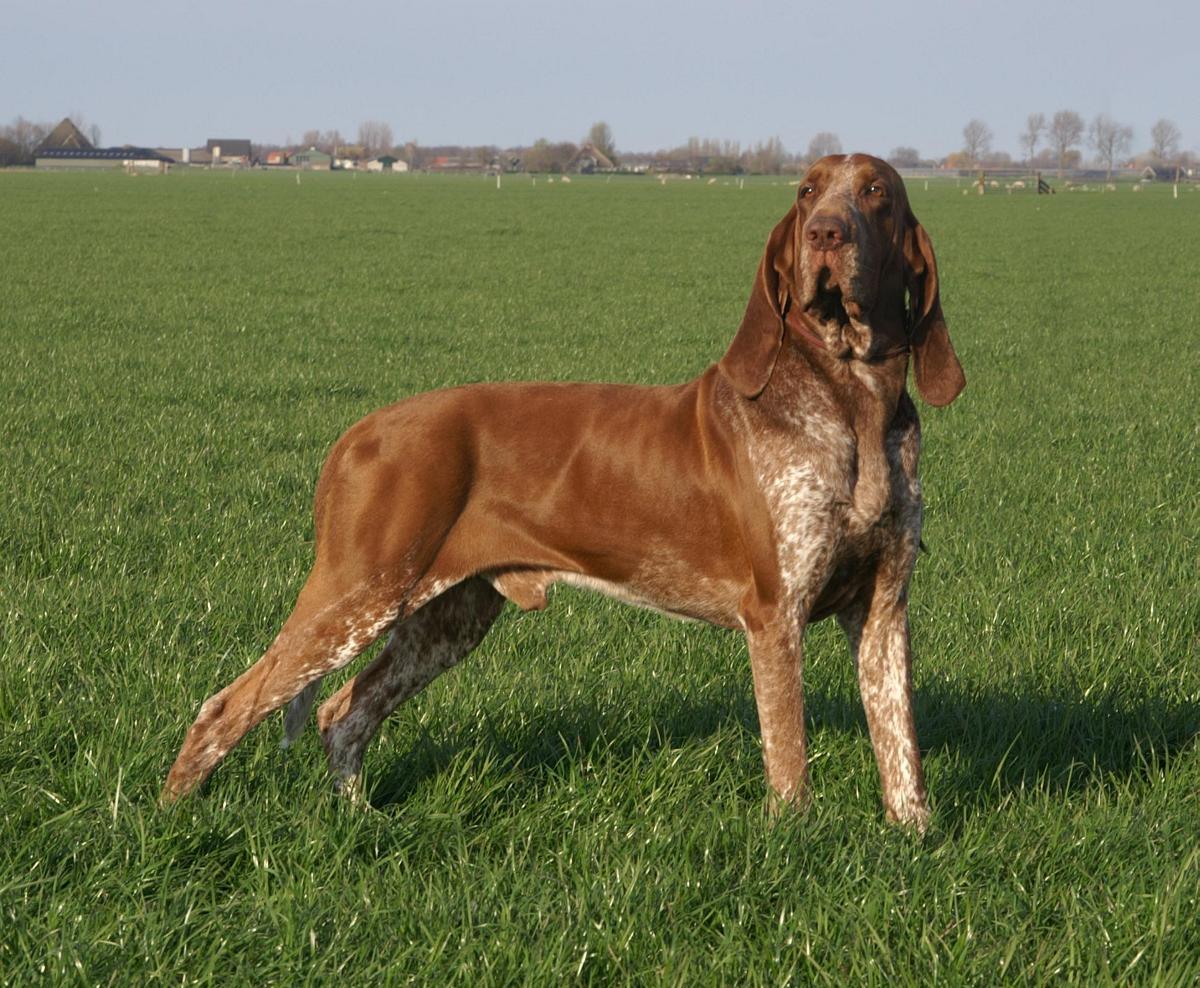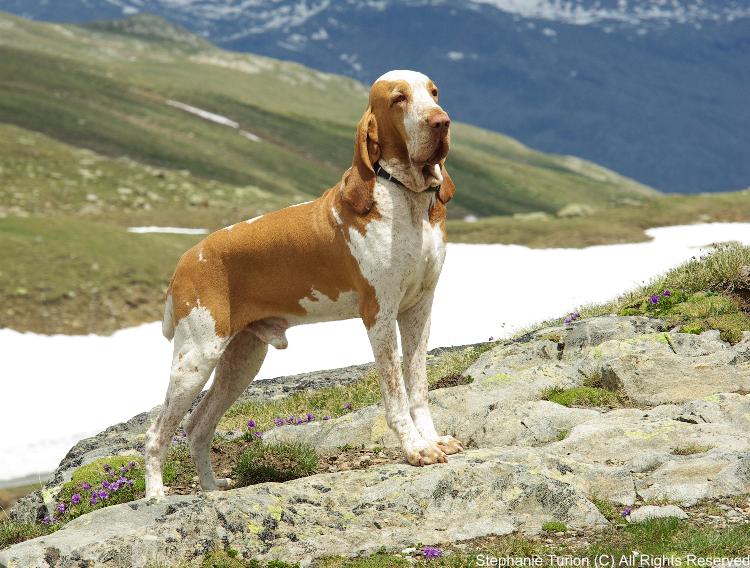|
Breed Standard
Bracco Italiano (Italian Pointer)
Origin: Italy
FCI classification: 202 Group 7 (pointing dogs) section 1.1 (Continental
Pointing Type "Braque") with working trail.

ENCI Bracco Italiano FCI Standaard
(Engels)
BRIEF HISTORICAL SUMMARY - This dog is one of the classic and
ancient pointers, selected mainly in the northern regions of this
peninsula. It is thought that the white-and-orange variety originated
in Piedmont and the roan-and-brown in Lombardy; in fact people
spoke of a Lombard pointer (the roan-and-brown) and a Piedmontese
pointer (the white-and-orange). The breed has been present since
the Middle Ages and became widespread in the Renaissance period.
It was held in very high regard by the nobility. In fact, feathered
game hunting was an exclusive appanage of the aristocracy. It
was bred by the Gonzaga and Medici families; the subjects born
in those kennels were sought out by nobles and royal families.
A serious countenance, tame and intelligent; docile, very diligent
in the hunt; very resistant with its nimble, ample and swift trot.
Strongly and harmoniously built with a vigorous appearance, very
distinct even in the hunt, head held high, a noble expression.
Born for the hunt, it is nonetheless an excellent companion dog.
 GENERAL
APPEARANCE - Of strong and harmonious construction, powerful appearance.
The preferred subjects are those with lean limbs, well developed
muscles, well defined lines with a markedly sculpted head and
a very obvious lower orbital chiselling, elements which all contribute
to give distinction to this breed. GENERAL
APPEARANCE - Of strong and harmonious construction, powerful appearance.
The preferred subjects are those with lean limbs, well developed
muscles, well defined lines with a markedly sculpted head and
a very obvious lower orbital chiselling, elements which all contribute
to give distinction to this breed.
IMPORTANT PROPORTIONS
- Length of the body is the same or a little more than the height
at the withers. Length of head is equal to 4/1O of the height at
the withers, its width, measured at the level of the zygomatic arches,
is less than half its length. Skull and muzzle are of equal length
BEHAVIOUR AND TEMPERAMENT - Tough and adapted to all types of hunting,
reliable, endowed with an excellent ability to understand, docile
and easy to train.
 HEAD
- Angular and narrow at the level of the zygomatic arches, its length
corresponds to 4/10 of the height at the withers: the middle of
its length is at the level of a line which unites the inner angles
of both eyes: the upper longitudinal axes of the skull ad muzzle
are divergent, i.e. if extended the top line of the muzzle, emerges
in front of the occipital protuberance, ideally at mid-length of
the skull. HEAD
- Angular and narrow at the level of the zygomatic arches, its length
corresponds to 4/10 of the height at the withers: the middle of
its length is at the level of a line which unites the inner angles
of both eyes: the upper longitudinal axes of the skull ad muzzle
are divergent, i.e. if extended the top line of the muzzle, emerges
in front of the occipital protuberance, ideally at mid-length of
the skull.
SKULL REGION - Seen in profile, the skull shape is a very open arch.
Seen from the top, it forms lengthwise an elongated ellipse. The
width of the skull, measured at the level of the zygomatic arches
should not exceed half of the length of the head. Cheeks are lean,
the bugle of the forehead and the supraorbital ridges are perceptible,
whereas the stop is not pronounced. The frontal groove is visible
and ends at mid-length of the skull. The interparietal crest is
short and not very prominent. The occipital protuberance is pronounced.
FACIAL REGION
Nose - Voluminous, with large well opened nostrils, protrudes slightly
over the lips with which it forms an angle. Colour: brown or from
pale pink to more or less deep fleshy red depending on the colour
of the coat.
Muzzle - Foreface either straight or slightly arched. Its length
is equal to half of the length of the head and its depth measures
4/5 of its length. Seen from the front, the lateral sides of the
muzzle converge slightly, still presenting a foreface of good width.
The chin not very apparent.
Lips - Upper lips well developed, thin and floppy without being
flaccid, covering the jaw; seen in profile, they overlap the lower
jaw slightly, seen from the front, they form an inverted "V" below
the nose; the corner of the lips must be marked without being droopy.
Teeth - Dental arches well adapted, with the teeth square to the
jaw; scissor bite - pincer bite is also acceptable.
Eyes - Semi-lateral position with a soft and submissive expression
neither deep set nor prominent. Eyes fairly large, eyelids ovalshaped
and close fitting (no entropion or ectropion). The iris is of a
more or less dark ochre or brown colour depending on the coat colour.
Ears - Well developed, in length they should, without being stretched,
reach the tip of the nose. Their width is at least equal to half
their length; raised only very slightly; base rather narrow, set
rather backwards at level of zygomatic arches: a supple ear with
a front rim well turned inwards and really close to the cheek is
appreciated; the lower extremity of the ear ends in a slightly rounded
tip.
 NECK
- Powerful, in truncated cone shape, length not less than 2/3 of
the length of the head, well detached from the nape. The throat
shows a soft double dewlap. NECK
- Powerful, in truncated cone shape, length not less than 2/3 of
the length of the head, well detached from the nape. The throat
shows a soft double dewlap.
BODY
Topline - The upper profile of the back is made up of two lines:
one, almost straight, slopes from the withers to the 11th dorsal
vertebra; the other is slightly arched, joining with the line of
the rump.
Withers - Well defined, with the points of the shoulder blades well
separated.
Loin - Wide lumbar region, muscled, short and slightly convex.
Rump - Long (about 1/3 of the height at the withers), broad and
well muscled; the pelvic angulation (angle formed by the pelvic
girdle with a horizontal line) is 30ƒ. Pelvis wide.
Chest - Broad, deep and well down to level of elbows, without forming
a heel, with well sprung ribs, particularly in their lower part,
and sloping.
Underline - lower profile almost horizontal in its ribcage part,
rising slightly in its abdominal part.
Tail - Thick at the base, straight,
with a slight tendency to taper; hair short. When the dog is in
action and especially when questing, it is carried horizontally
or nearly. The natural tail should not extend below the hock and
have the above-mentioned features. If docked, for hunting purposes
and in compliance with health and animal welfare, the tail must
have a length of 15–25 cm from the root.
 LIMBS LIMBS
Forequarters - Shoulder strong, well muscled, long and sloping,
very free in its movement; the upperarm sloping, fitting to the
ribcage; forearm strong, straight, with strong and well marked sinews;
the point of the elbows should be on a perpendicular line from the
rear point of the shoulder blade to the ground; metacarpus (pasterns)
well proportioned, lean, of good length and slightly sloping; feet
strong, slightly oval shaped, well arched and closed toes with strong
nails well curved towards the ground. Colour of nails is white,
yellow or brown, of a more or less dark shade depending on the colour
of the coat: pads elastic and lean. Hindquarters - Thigh long, parallel,
muscular, with a rear edge almost straight; strong limbs; hocks
wide, metatarsals relatively short and lean. The feet with all the
characteristics of the front feet, have dewclaws, the absence of
which is not a fault. Double dewclaw is tolerated.
GAIT/MOVEMENT-Extended
and fast trot, with powerful impulsion from the hindquarters; head
raised, nose held high in such a way that, when hunting, the nose
is higher than the top line.
 SKIN
- Tough but elastic: fine on the head, the throat, inside the elbows
and on lower part of the body. The visible mucous membranes must
be a corresponding colour with the coat, but never show black spots.
The mucous membranes of the mouth are pink; in the roans or white
and chestnut coloured dogs they sometimes show brown or light chestnut
spotting. SKIN
- Tough but elastic: fine on the head, the throat, inside the elbows
and on lower part of the body. The visible mucous membranes must
be a corresponding colour with the coat, but never show black spots.
The mucous membranes of the mouth are pink; in the roans or white
and chestnut coloured dogs they sometimes show brown or light chestnut
spotting.
COAT Hair - Short, dense
and glossy, finer and shorter on the head, the ears, front part
of the legs and feet. Colour- o White. o White with patches of varied
size of an orange or more or less dark amber colour. o White with
more or less large chestnut patches. o White speckled with pale
orange (melato). o White speckled with chestnut (roano-marrone).
In this last combination, a metallic sheen is appreciated, and a
warm shade of chestnut is preferred, recalling the colour of a monk's
robe. A symmetrical facial mask is preferred, but the absence of
a mask is tolerated.
 SIZE
AND WEIGHT - Height at the withers between 55-67 cm. preferred size
for males: 58-67 cm - preferred size for females: 55-62 cm. Weight
between 25 and 40 kg. depending on height. Males should have two
apparently normal testicles fully descended into the scrotum. SIZE
AND WEIGHT - Height at the withers between 55-67 cm. preferred size
for males: 58-67 cm - preferred size for females: 55-62 cm. Weight
between 25 and 40 kg. depending on height. Males should have two
apparently normal testicles fully descended into the scrotum.
FAULTS - Any departure
from the foregoing constitutes a fault which when judging must be
penalized according to its seriousness and its extension.
Elimination faults - Accentuated prognathism.
- Size 2 cm. above or below limits
indicated in the standard.
Discualifying faults
- Split nose
- convergence of cranial-facial axes
- wall eye
- upper prognatism
- absence of pigmentation (albinism)
- black coat; white and black
- tricolour; fawn, hazel, unicolor,
with tan markings, mucous membranes
- skin and annexes with traces of
black.
|


 HEAD
- Angular and narrow at the level of the zygomatic arches, its length
corresponds to 4/10 of the height at the withers: the middle of
its length is at the level of a line which unites the inner angles
of both eyes: the upper longitudinal axes of the skull ad muzzle
are divergent, i.e. if extended the top line of the muzzle, emerges
in front of the occipital protuberance, ideally at mid-length of
the skull.
HEAD
- Angular and narrow at the level of the zygomatic arches, its length
corresponds to 4/10 of the height at the withers: the middle of
its length is at the level of a line which unites the inner angles
of both eyes: the upper longitudinal axes of the skull ad muzzle
are divergent, i.e. if extended the top line of the muzzle, emerges
in front of the occipital protuberance, ideally at mid-length of
the skull.  NECK
- Powerful, in truncated cone shape, length not less than 2/3 of
the length of the head, well detached from the nape. The throat
shows a soft double dewlap.
NECK
- Powerful, in truncated cone shape, length not less than 2/3 of
the length of the head, well detached from the nape. The throat
shows a soft double dewlap.  LIMBS
LIMBS
 SKIN
- Tough but elastic: fine on the head, the throat, inside the elbows
and on lower part of the body. The visible mucous membranes must
be a corresponding colour with the coat, but never show black spots.
The mucous membranes of the mouth are pink; in the roans or white
and chestnut coloured dogs they sometimes show brown or light chestnut
spotting.
SKIN
- Tough but elastic: fine on the head, the throat, inside the elbows
and on lower part of the body. The visible mucous membranes must
be a corresponding colour with the coat, but never show black spots.
The mucous membranes of the mouth are pink; in the roans or white
and chestnut coloured dogs they sometimes show brown or light chestnut
spotting.  SIZE
AND WEIGHT - Height at the withers between 55-67 cm. preferred size
for males: 58-67 cm - preferred size for females: 55-62 cm. Weight
between 25 and 40 kg. depending on height. Males should have two
apparently normal testicles fully descended into the scrotum.
SIZE
AND WEIGHT - Height at the withers between 55-67 cm. preferred size
for males: 58-67 cm - preferred size for females: 55-62 cm. Weight
between 25 and 40 kg. depending on height. Males should have two
apparently normal testicles fully descended into the scrotum.